From the farms of Vietnam to the cup in front of the customer
The majority of coffee produced in Vietnam comes from plantations in the central highlands. Coffee farmers here have owned their farms for generations. Meeting any of them, you will be encountered with nothing but friendliness, welcome, and warmth. Just like in Vietnamese meals such as pho, the work Vietnamese farmers do to grow fresh vegetables, herbs, and ingredients counts for everything.
What makes Vietnamese coffee different from other varieties?
Vietnamese coffee has a strong, concentrated flavor that some say borders on what alcohol tastes like. How Vietnamese coffee is made relies on roasting the beans at low heat for approximately 15 minutes. This happens before the coffee is even made. Another key difference with Vietnam coffee is that machines are not used for roasting, which is common in other countries.
After the beans are roasted, the coffee is loaded into a filter and remains there until all flavour drips into the coffee. No machines or electric filters are used. This is the traditional Vietnamese way.
Getting to know more about the Robusta coffee bean
Robusta coffee beans contain more than double the caffeine of Arabica beans. They are very potent, with a high acidity level and an almost burnt rubber taste to them. They are bitter, they are strong. For North Americans used to North American-style coffee, having your first cup of Vietnamese coffee will probably result in you not liking it. It is very, very different from non-Vietnamese or non-Robusta coffee.
A cup of Nau or a cup of den
Trademark Vietnamese coffee is dark and intense but a consumer doesn’t need to have it Robusta-style. Many people enjoy a cup of Nau which is coffee mixed with condensed milk, or den which is strong, black coffee. There are also other varieties of Vietnamese coffee outside of Robusta beans.
? ‘Egg yolk coffee’ comes across as a cappuccino-style beverage. If you haven’t had a coffee with egg yolk in it, it’s not uncommon to balance it out with generous cream. Needless to say, Canadians find this recipe very unusual.
? ‘Yogurt coffee’ stems from a shortage of milk which once occurred in Vietnam. Unwilling to part with their coffee culture, what did they use instead – yogurt!
? ‘Fruity coffees’ are only for those who want to go big, bold, and different. Fruity coffees from Vietnam traditionally involved mashing bananas or incorporating similarly mashed avocados in a cup. This created not only a flavored coffee but something that was creamy, thick, and bordering on a dessert.
? ‘Ca Phe da’ is also a version of Vietnamese coffee served over a bed of ice. It can be considered a sort of cold or lukewarm coffee which makes consuming coffee on a summer’s day a little more tolerable to some. Traditionally, hot coffee is made for the morning while iced coffee is perfect for later in the day.
How to brew coffee Vietnamese-style
Are you looking for a recipe on how to brew coffee Vietnamese-style? Instructions are simple. Think of it like a combination of French roast coffee dripped through a Vietnamese coffee filter and then, mixed with condensed milk.
Boil some water. Preheat the filter and cup by pouring boiling water through it. Pour a heaping tablespoon of ground coffee bean in, after removing the metal filter. Twist the filter on gently. Condensed milk can be added to the cup before brewing. The boiling water will actually cook it. Pour some water it the filter to wet the grind a little bit. Fill the filter all the way now and let it drip. Within 3-5 minutes, you’ve brewed a heck of a cup of coffee.
Alternatively, for an iced coffee, all you have to do is to fully dissolve the condensed milk beforehand and then to pour the coffee over a glass filled with ice afterwards. Ta da!
A culture of export
The coffee culture in Vietnam is strong however so much of the Vietnamese coffee beans are shipped to export. Vietnam remains the second-biggest coffee producer, primarily exporting it across countries like Germany, the US, Spain, Luxembourg, Belgium, Italy, France, Poland, South Korea, the UK, and Japan. Although once arrived the coffee created is so much different compared to a traditional cup, the bean and the cultivation is still uniquely Vietnamese.
Can you make Vietnamese coffee at home?
The only drawback to making Vietnamese coffee at home is that it does take time. Much like preparing a pho broth which can take an entire day, coffee takes time though not a whole day. If you can find a traditional Vietnamese coffee press filter, that’s an excellent step towards achieving an authentically prepared beverage. For the real coffee lovers out there, this is one coffee you’ve got to try. Done the right Vietnamese-style.






















